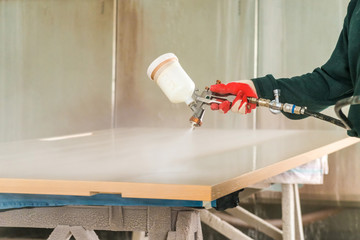Home » Articles posted by Holly Thaxton
Author Archives: Holly Thaxton
Cabinet Painting Mistakes to Avoid
Cabinets get a lot of wear and tear, so they need a good paint job to look new again. Before you start painting, remove all the hardware and doors. This lets you keep the cabinets out of the way, making painting easier. Here are some mistakes to avoid, whether you’re doing it yourself or hiring a pro. Read on Cabinet Painting to learn more.

To prep, the cabinets for painting, clean them thoroughly by scrubbing them with soapy water and an abrasive pad dipped in a degreasing cleaner, which will help ensure pristine paint adhesion. To avoid brush drips or paint splatter, prepare your work area by covering furniture and floors with tarps. Also, tape off walls and countertops so they don’t get paint on them.
After cleaning, remove cabinet doors and hardware. Label each set and place them in zip-up bags or small jars for easier reinstallation later. Painting your kitchen cabinets can be an excellent do-it-yourself project depending on your skill level and time frame. However, hiring a professional may be the better option if you’re not sure you have the patience or want a finished product that looks like it came out of a magazine.
Priming is the best way to prepare a surface for painting. It helps solve problems with porosity, odors, stains, and adhesion issues. It also seals and protects the wood from moisture, mold and mildew, and rot. It can be applied over bare wood or manufactured composites and dries quickly to the touch.
There are many different types of primers available to choose from. Some of the most popular include water-based, oil-based, and hybrid acrylic urethanes. Oil-based primers are excellent at sealing stains and blocking tannins seeping through oak, knotty wood, and other wood cabinets. They also offer the best bonding and adhesion.
Sanding is an important part of the cabinet painting process. It removes previous finishes, such as varnish, that interfere with paint adhesion and smoothes the surfaces for priming. It also helps make wood more receptive to stain and oil finish. It’s best to sand the surface before applying any stain or finishing coat.
Before sanding, clean the cabinets with trisodium phosphate or another degreaser. This will help remove grease, steam and food splatters, which can prevent paint from sticking properly. Sanding is a messy and dusty job, but it’s worth the effort to get a smooth, factory-like finish for your kitchen cabinets. It’s also essential if you want your finished cabinets to last for years.
Caulking is the process of sealing cracks and gaps in doors, windows, baseboards, and ceiling trim to prevent air leaks, reduce water damage, and block out pests. It also creates a smooth edge around doors and windows for a clean professional look.
There are several types of caulking, including silicone, latex, and butyl rubber. The type you choose depends on the area where you plan to use it and the paint you’ll be applying on top of it.
When painting cabinets, always caulk the cabinet door and where the cabinets meet. This is a more likely place for a gap to occur, and it will be less noticeable if you caulk before painting.
Cabinet painting can be a quick and inexpensive way to update your kitchen. However, it’s important to evaluate the condition of your cabinets before painting them.
If they’re peeling, delaminating, sagging or cracking, it may be better to replace them instead of painting them. This will save you money in the long run since repairs are expensive.
When selecting the paint to use on your cabinets, choose a product that’s durable, easy to clean and provides a smooth, hard finish. This can mean choosing an oil-based or latex product.
A cabinet painting is usually a quite tiny painting, usually no bigger than two feet by two feet, sometimes even smaller, but most often a lot smaller. The word is also used for paintings which display full-length, large-scale paintings or landscape in a comparatively small scale, instead of a portrait or lifelike object usually painted on life-size. There are also instances when these are used to cover flaws and scuffs on the surface of furniture. Sometimes called as “doublies,” cabinet paintings can be considered as an affordable alternative to having an antique furniture restoration done.
Painting cabinetry is quite easy and convenient. This is because they need not be repainted ever. For those who own wood-burning fireplaces in their homes, there’s no better way to preserve them and display them without having to maintain their condition. A regular paint job, which is a mix of varnish and protective coating, will do for this purpose, and the result is long-lasting beauty.
